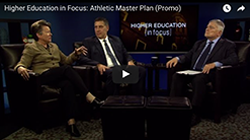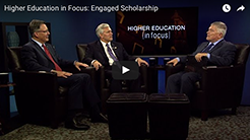It has been two long and challenging years under the cloud of a global pandemic. Given the new variants and uncertainty that still remains among medical experts, we can expect to be managing COVID-19 well into the future. However, it appears that we have turned a significant corner. The vaccines are widely available and have had their intended effect: Hospitalizations are down, masks are largely optional and physical distancing is no longer a part of our social gatherings.
I realize that at this time in the semester, everyone is going at 100 miles per hour. But I want to take a moment to pause and thank you for helping us to adjust and adapt to COVID-19. Moving Penn State’s vast, complex organization to primarily remote operations was an enormous undertaking with no precedent or pre-existing plan to follow. The fact that we were largely successful is a credit to the entire Penn State community and our many partners throughout the Commonwealth of Pennsylvania. It was inspiring and deeply gratifying to see how everyone came together to adapt and adjust to new technology, new procedures for health and safety, economic hardships resulting from the pandemic, mental and physical health issues related to COVID-19, and countless other changes to our personal and work lives. ‘Incredible’ doesn’t begin to describe the effort that spanned our teaching, research and service operations.
To give you an idea of the scope, consider a few key statistics:
- 176,398 tests administered at the White Building at University Park campus
- 645,267 Vault Health PCR tests distributed across all Penn State locations
- 2,780,000 procedural masks purchased
- 12,902 clear masks purchased
- 23,000 face shields purchased
- 350,000 Penn State-branded cloth masks purchased
- 10,680 gallons of hand sanitizer purchased
- 523 FAQs published on Virus Info
- 227 enhanced cleaning events by OPP’s specially trained team
- 4.1 million pageviews on Virus Info
- $131.2 million in federal Higher Education Emergency Relief Funds disbursed directly to students
There are too many individuals to name when it comes to offering our gratitude. But I would be remiss if I didn’t recognize a few of the people who led the overall effort.
I’ll begin with Provost and Executive Vice President Nick Jones, who played — and continues to play — a crucial role in navigating our University forward. From the earliest stages of the pandemic, Nick formed the COVID-19 Management Team (CMT), which includes the chair of the University Faculty Senate and key University leaders. He was on the front lines, dealing with our community’s uncertainty, fear and frustration. I’m very grateful for his leadership.
I also need to recognize Kelly Wolgast, who put aside her day job as a professor and administrator in Ross and Carol Nese College of Nursing to lend her expertise to the University’s efforts. She led the COVID-19 Operations Control Center by bringing together all the right people with the right expertise from across the University. Her counsel and expertise were indispensable every step of the way.
Our gratitude and admiration go to everyone who enabled the shift to remote teaching and learning — including our faculty who quickly pivoted their classes to remote — while much of the University was on spring break. The rapid response by our faculty and staff enabled 63,000 students to log online by 10 a.m. on the first day of remote classes. Over the following two years, they worked across the University to improve the experience and offer support to students and faculty.
Our researchers pivoted to provide support in every possible way, including our epidemiologists, who provided invaluable expertise. The Huck Institutes of the Life Sciences provided $2.25 million to 47 teams of researchers from three campuses, 10 colleges and 25-plus departments to conduct COVID-19 research. They donated personal protective equipment, monitored wastewater, provided medical expertise, created educational videos and much, much more.
Meanwhile, Strategic Communications kept everyone informed. Beginning in February 2020, they worked tirelessly to communicate to all of the campuses across the commonwealth through messaging, the Virus Info website, and town halls. Often, the news wasn’t what people wanted to hear, but in the face of great uncertainty, they provided clear, concise messaging to our community.
The staff in Student Affairs also worked around the clock. In addition to their regular jobs, they took on and led successful contact tracing, quarantine and isolation, student care and advocacy, CAPS, University Health Services and student conduct, while helping to support students who are directly suffering from the medical and financial effects of the pandemic. There were many long days and longer nights. They gave their all to this University.
Penn State’s many community partners also stepped up to help, and their support was essential. Notably, Mount Nittany Health, Centre Volunteers In Medicine, State College Area School District, Walmart, CVS, Weis Foods, and many others were instrumental in the vaccine effort. We also appreciate that the governing bodies in our local communities worked in concert with Penn State to provide consistent guidelines for masking, physical distancing, and other safety measures.
Testing was key to getting students, faculty and staff back on our campuses. Many of our Commonwealth Campuses faced special challenges related to the caseloads in their communities and limited options for testing. The Vault mail-in tests helped alleviate some of this stress. On the University Park campus, the Test and Surveillance Center (TASC) made a tremendous difference. Their shift to aid in testing and its rapid federal certification helped people confidently return to campus, and to monitor the spread of COVID in the community.
None of our efforts would have been successful without the cooperation of the student body. Our student leaders showed remarkable maturity in the face of so many disappointments. They became ambassadors, modeling the actions needed to mitigate spread to allow learning to continue in person to the extent possible.
There are hundreds more who deserve our thanks — from Penn State Health, Office of the Physical Plant, Global Programs, Emergency Management, Information Technology, Procurement, OPAIR, Housing and Food Services, Fleet Operations, Intercollegiate Athletics, Government and Community Relations, along with all of our incredible students, faculty and staff members who carried on under once-in-a-century circumstances.
Thank you one and all. This is not the last challenge that Penn State will face, but it’s clear that this community is well prepared to handle whatever comes this way. Well done all!




